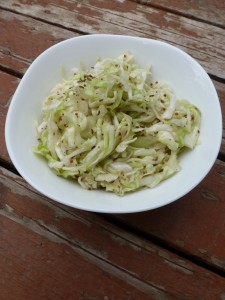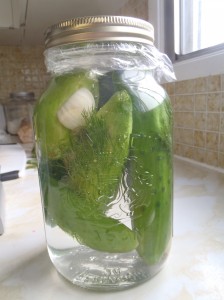Pork and cabbage for the win! A combination that transcends continents. Gyoza are Japanese “pot-sticker” dumplings, usually filled with ground pork and cabbage, though shrimp is also common.
I love this preparation because it is primarily made of local ingredients I often have on hand (pork and cabbage) but of course with the Japanese pantry items that take it in a completely different direction.
This is a very simple recipe. The only nuance is that you should grind the pork in the manner described in this sausage-making introduction. In other words, the pork should be about 25-35% fat by volume (pork butt is ideal), and should be properly chilled before grinding, and should be thoroughly mixed with liquid (soy … Continue reading.
This post was originally published on September 17, 2013. I’m re-posting it todayfor those that attended my session at Eat Alberta 2017.
 Kraut is German for “herb”. It was also a derogatory term for Germans during the Second World War. Sauerkraut means “sour herb”, or possibly “German curmudgeon”. Why this preparation would be called sour herb I have no idea.
Kraut is German for “herb”. It was also a derogatory term for Germans during the Second World War. Sauerkraut means “sour herb”, or possibly “German curmudgeon”. Why this preparation would be called sour herb I have no idea.
Ukrainian, Russian and several other eastern European languages use the word kapusta to refer to fresh cabbage, cured cabbage, and various dishes made with one or both of those.
Sauerkraut is a miracle preparation. Cabbage and salt. That’s it. Somehow liquid appears from thin air and submerges the cabbage. Over a few weeks, though neither cabbage nor salt are acidic, … Continue reading.
 Braised cabbage is wholly satisfying: warm and hearty and comforting in a way that vegetables usually only achieve in soup form. I guess it doesn’t hurt that there’s lots of pork fat in it, but the flavour of the cabbage is the star.
Braised cabbage is wholly satisfying: warm and hearty and comforting in a way that vegetables usually only achieve in soup form. I guess it doesn’t hurt that there’s lots of pork fat in it, but the flavour of the cabbage is the star.
With slaw and sauerkraut, braised cabbage forms what I call the trinity of cabbage preparations. It is a cherished dish at Thanksgiving, and any wintry night.
Cook some type of fatty pork – bacon, loose sausage, and jowl all fit the bill – until it is golden brown and has rendered some golden fat into the pot.
Cook sliced onions and garlic in the pork fat until starting to turn translucent. Add the cabbage and cook briefly, … Continue reading.
 Recently I was shocked to discover that many people have bad childhood memories of “creamy” coleslaw. I was raised on chopped cabbage in mayonnaise, a creamy slaw that we called cabbage salad. Many detest this side dish so much that they have given up slaw all together.
Recently I was shocked to discover that many people have bad childhood memories of “creamy” coleslaw. I was raised on chopped cabbage in mayonnaise, a creamy slaw that we called cabbage salad. Many detest this side dish so much that they have given up slaw all together.
I’d like to vouch for a different style of coleslaw, one that has more in common with the German Krautsalat than the classic mayo-bound North American slaw.
The main difference is that it’s dressed in a vinaigrette, instead of mayonnaise or buttermilk. But before we discuss dressing, there’s a very important technique to consider.
Lightly Curing Cabbage for Slaw
There are very few vegetables that I truly enjoy raw. Good carrots, radishes, and … Continue reading.
 I come from a land of “refrigerator pickles”: cucumbers steeped in syrupy vinegar and spices, and stored in the fridge through the fall. There is another type of pickle called a lacto-fermented pickle. The idea of producing an acidic pickle with only brine was a revelation.
I come from a land of “refrigerator pickles”: cucumbers steeped in syrupy vinegar and spices, and stored in the fridge through the fall. There is another type of pickle called a lacto-fermented pickle. The idea of producing an acidic pickle with only brine was a revelation.
There are two ways to apply the salt and control the salt concentration: either dry salt can be added directly to the ingredient, or the ingredient can be submerged in a brine.
Direct Salting. This method is more common when the ingredient to be fermented has been sliced or chopped finely. Sauerkraut is the most familiar example in the west. For this method we typically add about 2% of the weight of the ingredient … Continue reading.
The personal website of Edmonton chef Allan Suddaby


 Braised cabbage is wholly satisfying: warm and hearty and comforting in a way that vegetables usually only achieve in soup form. I guess it doesn’t hurt that there’s lots of pork fat in it, but the flavour of the cabbage is the star.
Braised cabbage is wholly satisfying: warm and hearty and comforting in a way that vegetables usually only achieve in soup form. I guess it doesn’t hurt that there’s lots of pork fat in it, but the flavour of the cabbage is the star. Recently I was shocked to discover that many people have bad childhood memories of “creamy” coleslaw. I was raised on chopped cabbage in mayonnaise, a creamy slaw that we called cabbage salad. Many detest this side dish so much that they have given up slaw all together.
Recently I was shocked to discover that many people have bad childhood memories of “creamy” coleslaw. I was raised on chopped cabbage in mayonnaise, a creamy slaw that we called cabbage salad. Many detest this side dish so much that they have given up slaw all together.